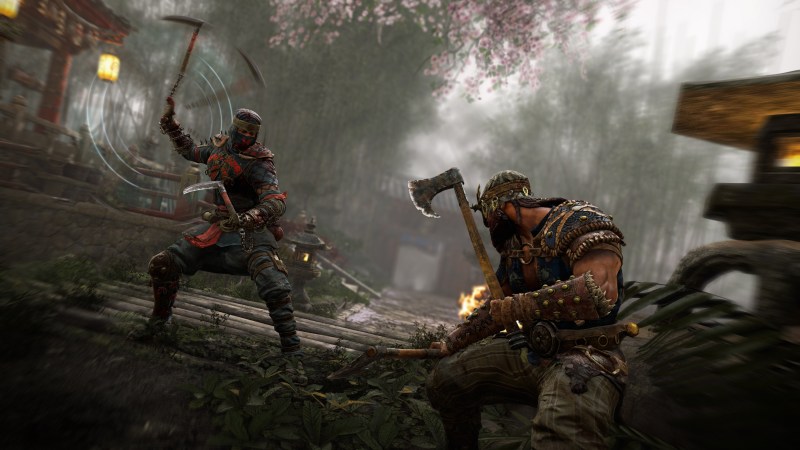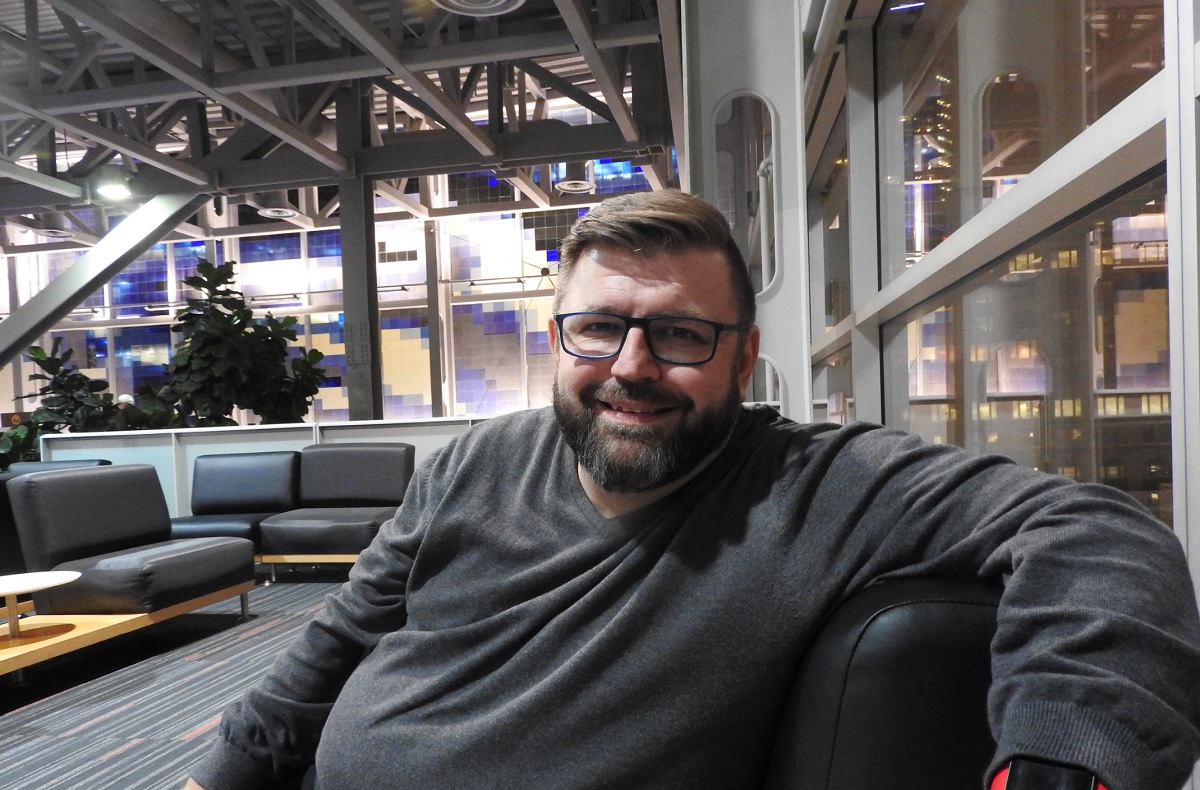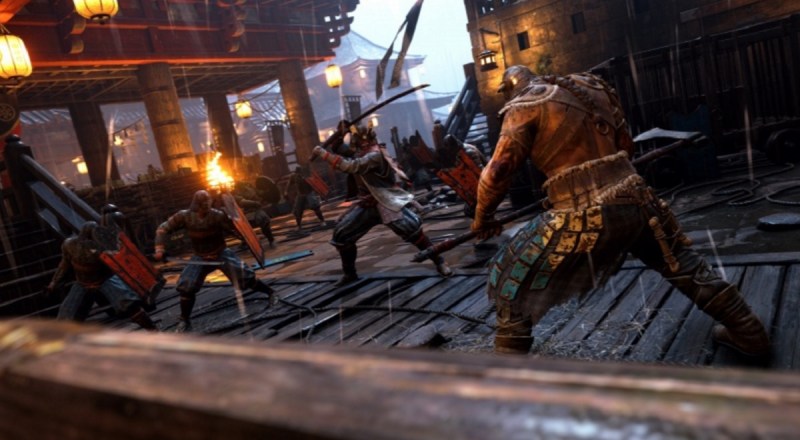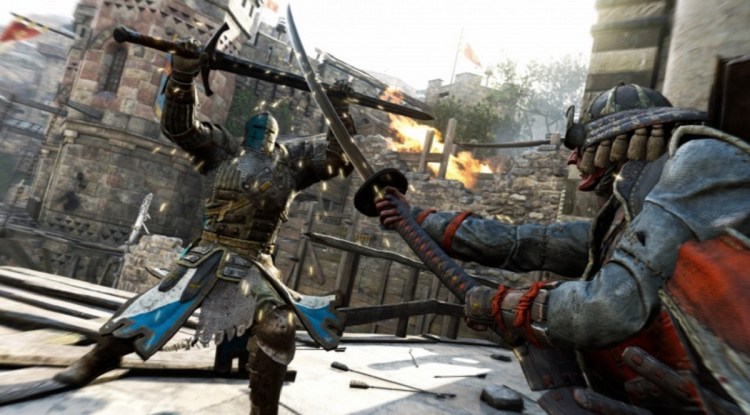Shoot-em-ups are a popular genre in video games. But Ubisoft wanted to make a “chop-em-up” melee game, and it had to think hard about how to create a new brand and a new kind of game with its launch of For Honor.
The responsibility for this task fell to the only marketing guy on the initial For Honor team. Luc Duchaine was the brand director of For Honor, the sword fighting game that debuted earlier this year. He gave a post-mortem talk at the 2017 Montreal International Game Summit (MIGS 17) about creating a new brand and intellectual property, which is something that Ubisoft does on a regular basis. But Ubisoft often stands alone in that expertise, as creating brand new triple-A games is increasingly rare.
Duchaine was on the team during its conception stage, reporting to the producer of the game, Stephane Cardin. For Honor was the brainchild of Jason VandenBerghe, creative director, who wanted to deliver a visceral combat game that showed what it was like to be a samurai, viking, or knight in a brutal battle. It was, he decided, what special forces soldiers would be like in the medieval times. The brand was about bringing that fantasy to life.

Above: For Honor’s shinobi.
They began their work as a team in the fall of 2013, when the project won internal approval. Duchaine wanted to get the branding right early on and create assets and previews that would convince players that they wanted to play the game and proselytize their friends. They did so by imagining the target players — like a recreational fighter or an elite esports athlete.
At the E3 trade show in 2015, VandenBerghe got up on stage and gave a speech that was 148 words long. Every word had been pored over for three months, and every gesture he made had been thought about in advance. Ubisoft then showed a live four-versus-four multiplayer match that culminated with a knight’s beheading.
“Would you turn and run? Would you stand and fight?” VandenBerghe said as he unveiled the game. The ultimate results were good, and the game sold well.
Here’s an edited transcript of our interview.


Above: Luc Duchaine was brand director of For Honor at Ubisoft.
GamesBeat: Are you here in Montreal most of the time?
Luc Duchaine: Yeah, I’m based in Montreal. I joined For Honor in the summer of 2013 as a brand director. I’m the marketing guy on the dev team. I have a marketing team with me. That’s a great thing about Ubisoft. We have marketing people embedded with the dev team, so we can start working very early on the long-term future of the brand, where we go with the brand.
GamesBeat: That sounds very unusual, that you would join the team so early.
Duchaine: For us, it’s usual. That’s how we work at Ubisoft. We have marketing people on every project, very early on. It has strong benefits. Quite early, you can work with the creative director, work with the producer, and try to identify the essence of the game. You have some time to influence as well — maybe this would be better for the game in the long term. I’ve been doing this for 13 years now.
GamesBeat: Do you report upward to the game director, then?
Duchaine: To the producer, yeah. And then, in our case, the producer answers to the CEO of the studio. The producer is responsible for the overall delivery and quality of the game. Marketing is part of the success of the game, so that’s why they’re responsible. The producer is on top of everything on the project. The creative director reports to him, the brand director, and the art director.
GamesBeat: Is there a game director as well on that level?
Duchaine: No, the producer is in charge. Then, you can have an executive producer if there are multiple projects under the same brand.
GamesBeat: What sort of input did you have that early on with For Honor?
Duchaine: The idea was already there. Where I worked a lot, with Jason for example — we looked at the core audience. We needed that for game design. Who do we design this game for? What features will please each player? We worked together to define those personas. That’s one place where I had some input. Also, when we came up with a sentence about the theme of the game — by working together, we managed to build the entire core idea around our communication based around that. When we did our demo at our first E3, I worked closely on the original idea for that, the original flow.
GamesBeat: When you have the four types of players, do you consider that to be fairly precise? Something you researched?
Duchaine: What we did, we had those personas. Then, moving on, we did some surveys to look at, is that accurate? We did research post-launch as well to try to identify who they were. There were some little differences, obviously. Some were done based on research we had done, and now, we had more data points to see if we were accurate or not. That helped us know — this type of gamer, for instance, we didn’t expect that to be so big, or we thought it would be bigger.

Above: Action in For Honor.
GamesBeat: Would you have maybe not gone forward without that, without that clear description of an audience? Why was it so important to identify that?
Duchaine: For me, it’s important because — maybe we would have come to the same point in the end. I don’t know. But it’s important for me, even when you design the game and when you build the campaign, to have this picture of who you’re making the game for. It helps to keep the focus. For me it was helpful to — OK, what would Mike think? One was named Chris. One was James. We tried to always bring in that thinking.
I’ve seen this at Ubisoft sometimes. People would print posters on the wall, to always keep that in mind. One thing that’s different now, the market is bigger. Game devs are no longer necessarily their own core audience. You always need to remember who you’re making your game for.
GamesBeat: The messaging at E3, the 148 words or so, you said that was something you looked at for three months. It sounds very meticulous. What kind of discussions were you having? Why was some of that wording so important?
Duchaine: The first discussion is, OK, what’s the focus of the speech? Where do we want to go with that? Having an overall direction for the speech. Once you’ve determined that, then you have other discussions. Do I want to go more here, more there, in this direction? Then, you have to write it down. Sometimes, you’ll compromise on certain things because the flow doesn’t work, or it gets too long.
We wanted something short, something more impactful, rather than going into too much detail. That’s not that point. At E3, you have Microsoft in the morning, EA before us, and then, Sony afterward. You have four big press briefings, seven hours long….
GamesBeat: Did you have a time limit?
Duchaine: They didn’t give us a number of minutes. Our demo was two minutes long, the speech was two minutes, and the trailer was three and a half. We were under 10 minutes overall, which was a good amount of time to have a big impact. Sometimes, taking more time — you can let yourself be seduced by that, but to me, it’s a trap. When you go too long, that’s when your message gets diluted. You want to create an impact. You want people to walk out saying, “Wow, that’s impressive.” You don’t want them looking at their watches and wondering what’s next.
GamesBeat: Who would have been in the room as you were dicing up these words?
Duchaine: Jason, the creative director. We also had a communications manager on the team, and myself. It was the three of us looking at it. When we did rehearsals internally, we had more people attending those. They could listen in and say, “Well, I don’t understand why you’d say that and not this.” We gathered their feedback, and we went back and changed some things. But we went for impact.
GamesBeat: Doesn’t that drive you nuts, to spend so much time on something so small?
Duchaine: No, not me. It’s actually what I like. There are some days where it’s like, “Shit, again?” When you think you’ve nailed it and you have to go back. But it didn’t drive me nuts. It helps me focus. The announcement was big. We’d been working on that for almost two years before. I don’t know if people are aware, but it takes almost a year to plan something like that, when you’re working on a big CGI trailer. It takes a long time. We had this target in mind. We didn’t mind spending extra time on the speech because it was part of something bigger.

Above: A victorious Viking shows no mercy in For Honor.
GamesBeat: This is what you have to do in order to create a new brand, something nobody’s ever seen?
Duchaine: Exactly. There are lots of big brands. You go to E3, and you’ll see a bunch of sequels being announced. You need to break through and make your place. That’s why every detail needs to be accounted for. That doesn’t mean you’ll succeed every time. Sometimes, people just aren’t interested. But it’s important to try.
GamesBeat: Getting out there early and often, getting feedback, getting this into the hands of the community, that’s all brand building? Going wide as soon as you can.
Duchaine: For us, it was part of our brand personality, to go out there early and gather feedback, to bring people into the world. It was all part of what we wanted to do, very early. When I joined the project, it was clear that we wanted to be as broad as possible.
GamesBeat: You have that risk that you might have to go back to the drawing board and redo something. You have to tell people, “Well, we’ll see you again in two years.”
Duchaine: It is a risk. It can happen sometimes. We didn’t have that problem, thankfully. But sometimes, that risk might be worth it, to gather feedback and say, “We’re going to adapt. We’re going to make it better.” It’s a risk we’re willing to take.
GamesBeat: Does that run counter [to] a lot of the usual advice you’ve heard, as far as the way things are done in game development?
Duchaine: At the time, it was a bit different from what we usually do. We had people who challenged us and said, “Why do you want to go out so early? Why do you want to play it on stage?” That was a big discussion. “You want to play four on four on stage? What’s wrong with you?” We had this belief, a strong belief, that we needed to do that to make an impact. That’s what we wanted to achieve.
I always go in to win. I don’t go in to be second fiddle. It doesn’t mean that you’ll always win, but we did everything we could. Today, two and a half years later, I have no regrets on that score.
GamesBeat: As far as postmortem goes, looking back today, what measured the impact it had? How successful was the whole brand approach?
Duchaine: You can look at a lot of things — sales, number of players, interaction on the community side, revenues. We have a list of [key performance indicators] we’re tracking. Being a live game is challenging. We haven’t announced any numbers. We’re quite shy on that.
GamesBeat: But it’s doing well from your perspective?
Duchaine: Yeah, we’re happy. One thing we have had to change is the servers. We had to move from peer-to-peer to a server-based game. It became the sort of elephant in the room, something people were talking about. We had to make that break. It took a lot of communication.
GamesBeat: Is there anything else you’ve noticed that suggests the branding worked?
Duchaine: There are always numbers, but it’s the engagement from people — cosplayers, community groups, tournament organizers — that’s where you can see that it’s here to stay. There are lots of passionate people out there. One thing that’s comforting in a way is that even though we had problems, which we’re fixing now, people who stopped playing because of those problems are saying, “OK, we’re going to come back. We love the game. We love the mechanics. Fix this and we’ll come back.” Now we’re fixing that.
It’s much better to hear that than people saying, “I don’t like the mechanics. I don’t like the fighting style. I don’t like the world you’re building.” If that’s the problem, they’ll never come back because the world won’t suddenly change. The core of our game will remain the same.
GamesBeat: Do you have more advice that you’d have, lessons you’d learn?
Duchaine: The first thing I talked about is, take the time to find your way. Take your time to find out what’s the purpose of your game and your marketing assets. If you fail to do that, to me, you’ll create assets that won’t appeal to people. They won’t interest people. It’ll just be a shot in the dark. It might work and it might not.
The second aspect was that no two projects are the same. What we’ve done with For Honor might not work for someone else. You have to keep an open mind, always. And if you’re doing a live game, be ready to adapt your plan. With live games, things will never go as you expected. You need to be ready to adapt and change your plans and make it better.

Above: That’s a big ax in For Honor.
GamesBeat: It sounds like you’re saying that some of marketing is a science, and some of it is an art.
Duchaine: It is for me. When we do trailers, sometimes we do research. We have data. But part of it is just art. Sometimes, there’s just something in how you feel about it. I think about the “Mad World” trailer for Gears of War. It was just a piece of art. I’m sure they researched it with different songs and decided that this particular one had the most appeal, but to me, it was truly a piece of art.
GamesBeat: It sounded like a big subject of discussion was chopping off the guy’s head.
Duchaine: Yeah, in the demo. One of the executions, when he sliced the head off — we had a discussion internally. Should it be a clean shot like, zip? Or does it go, shink, and then the head goes? What do we do? Is this too brutal? For us, when it sticks, it brings so much.
GamesBeat: It’s not about whether to chop a guy’s head off. It’s about how you chop a guy’s head off.
Duchaine: Exactly. The head was going, either way. That wasn’t in question. It was how and the detail in the animation at that precise moment. When I say no compromise on details — we had a big discussion about that one.
Disclosure: The organizers of MIGS 17 paid my way to Montreal. Our coverage remains objective.

